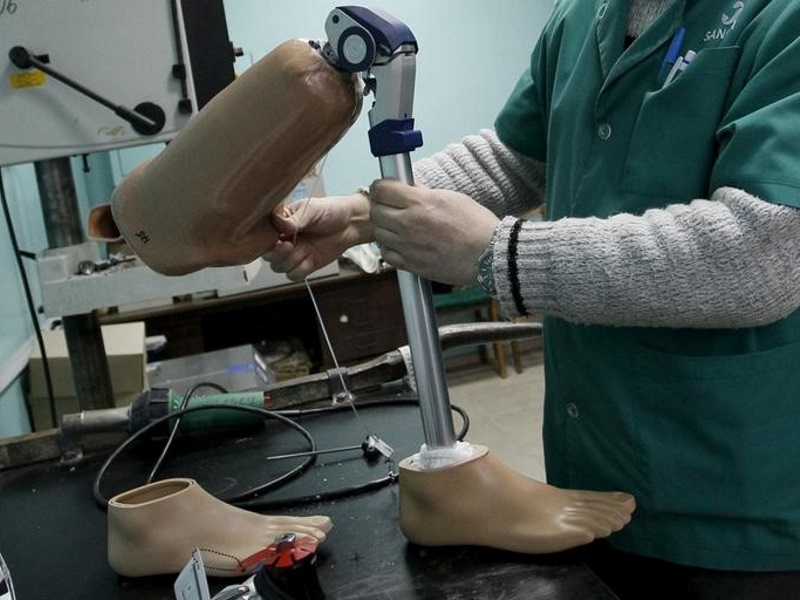- Home
- Science
- Science News
- Thought Controlled Prosthetics Possibly Within Reach, Scientists Say
Thought-Controlled Prosthetics Possibly Within Reach, Scientists Say

Animals have already been tested with the device, called a stentrode, which is the size of a matchstick and planted inside a blood vessel near the brain.
It uses a web of small electrodes to pick up neuron signals from the brain and converts them into electrical commands that may one day, the scientists hope, allow paralyzed patients to control a bionic limb or wheelchair.
"The big breakthrough is that we now have a minimally invasive brain-computer interface device which is potentially practical for long-term use," said Terry O'Brien, head of medicine at the Department of Medicine and Neurology at the University of Melbourne.
The current method for accessing brain signals requires complex open-brain surgery and becomes less effective over several months, which means it is rarely applied, he said.
The stentrode is less invasive because it can be inserted through a vein in a patient's neck and placed in a blood vessel near the brain.
The animal trial was on the functionality of the stentrode to pick up neuro signals, not the converting of the electronic signals into movement of bionic limbs, which is established technology.
Dr Ganesh Naik, from the University of Technology Sydney, who is not involved in the project, said animal trials did not always translate into successful human trials.
"If it functions as it should at the (human) trial, it will be a massive breakthrough," said Ganesh.
Other potential uses for the stentrode include monitoring the brain signals of people with epilepsy to detect an oncoming seizure. If successful, the device could also allow a patient to communicate through a computer, said Professor Clive May from the Florey Institute of Neuroscience and Mental Health, who is working on the project.
"People would need to be trained in how to think the right thoughts to make it work, like learning to play music. You need to learn it, but once you do, it becomes natural," May said.
The device was developed by Melbourne University, the Royal Melbourne Hospital and the Florey Institute of Neuroscience and Mental Health. The project is funded by both the Australian government and the US military, which sees potential benefits for paraplegic veterans.
© Thomson Reuters 2016
For the latest tech news and reviews, follow Gadgets 360 on X, Facebook, WhatsApp, Threads and Google News. For the latest videos on gadgets and tech, subscribe to our YouTube channel. If you want to know everything about top influencers, follow our in-house Who'sThat360 on Instagram and YouTube.
Related Stories
- Amazon Great Indian Festival 2024
- Big Billion Days 2024
- Apple Vision Pro
- Oneplus 12
- iPhone 14
- Apple iPhone 15
- OnePlus Nord CE 3 Lite 5G
- iPhone 13
- Xiaomi 14 Pro
- Oppo Find N3
- Tecno Spark Go (2023)
- Realme V30
- Best Phones Under 25000
- Samsung Galaxy S24 Series
- Cryptocurrency
- iQoo 12
- Samsung Galaxy S24 Ultra
- Giottus
- Samsung Galaxy Z Flip 5
- Apple 'Scary Fast'
- Housefull 5
- GoPro Hero 12 Black Review
- Invincible Season 2
- JioGlass
- HD Ready TV
- Laptop Under 50000
- Smartwatch Under 10000
- Latest Mobile Phones
- Compare Phones
- Vivo Y18t
- Honor X9c
- Honor Magic 7 Pro
- Honor Magic 7
- Sharp Aquos R9 Pro
- Xiaomi 15
- Xiaomi 15 Pro
- Redmi A3 Pro
- Asus Zenbook S 14
- MacBook Pro 16-inch (M4 Max, 2024)
- Huawei MatePad 11.5
- Acer Iconia Tab 10.36 (iM10-22)
- Redmi Band 3
- Xiaomi Smart Band 9 Pro
- Sony 65 Inches Ultra HD (4K) LED Smart TV (KD-65X74L)
- TCL 55 Inches Ultra HD (4K) LED Smart TV (55C61B)
- Sony PlayStation 5 Pro
- Sony PlayStation 5 Slim Digital Edition
- Acer 1.5 Ton 5 Star Inverter Split AC (AR15AS5INGMA)
- Daikin 1.5 Ton 4 Star Inverter Split AC (FTKT50UV16V+RKT50UV16V)

















